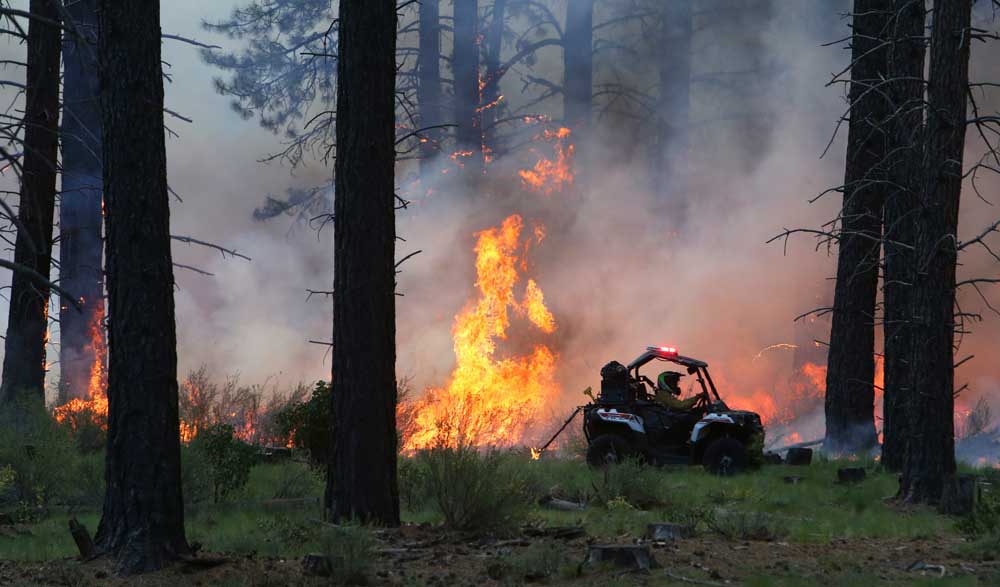Deschutes National Forest doubles prescribed burn treatments near Bend
Published 5:30 am Thursday, May 30, 2024

- Smoke billows up as a U.S. Forest Service employee drives a quad fitted with a drip torch in April 2024.
Wednesday was a perfect day to set the forest alight.
With blue skies and a light breeze blowing from the north, Burn Boss Robert Newey ordered his crew of around 50 firefighters to commence ignitions on a prescribed burn south of Cascades Lakes Highway near the Deschutes River.
Using drip torches, the firefighters walked straight lines through the forest, igniting brush and grasses. Soon the earth was scorched black with just a few flames lingering on low-hanging branches. The crew continued the process in the next section of forest, just a few yards away.
Newey said if conditions became too dry or windy, he could shut down the burn.
“I have extra resources on standby if I need to pull them in. We can put in a dozer line if we need to. That is not my intent, but it’s ready to go if we need it,” said Newey as he walked the fire line.
The 400-plus acre prescribed burn was part of an increased effort by the U.S. Forest Service to treat public lands in Central Oregon to prevent catastrophic wildfires. This year the Forest Service plans to complete between 7,500 and 10,000 acres of prescribed burning, double what was burned in recent years.
The increase in prescribed burns is made possible by injections of federal funds two years ago. Central Oregon was given $41.3 million to be spent on thinning operations and forest treatments including fire, mostly in the Deschutes National Forest.
Strategic deployment
The funding is deployed strategically, said Kevin Stock, Bend-Fort Rock district ranger. In perfect conditions, the agency would treat around 20,000 acres of forest a year but unpredictable weather and smoke management means only around half of that can be treated, he said.
Read more: Central Oregon to receive $18 million for wildfire resiliency efforts
“We’re not going to meet the goal of treating all the acres needed to restore the natural fire cycle, so we have to be strategic where we are burning,” said Stock. “It’s not about getting every acre treated; it’s about breaking up the continuity (of the forest).”
The burn on Wednesday was the final segment of a wider burn across the forest west of Bend. Future burns will be farther from the city. Similar treatments have been undertaken close to Sunriver, La Pine and Sisters.
Most of the prescribed burning occurs in spring when conditions are ideal to eliminate understory growth and fuels that can fuel wildfires in the height of summer. In the fall, the Forest Service burns woodpiles collected during thinning operations.
Return to burn
Stock said fire should be returned to the landscape every 10 to 15 years after a prescribed burn to maintain forest health. Funding for the current uptick in prescribed burns runs out after 2026, so officials must look for new funding to conduct future burns.
Stock said the next time treatments are needed near Bend the working conditions will be easier and operations smoother because large quantities of fuel were eliminated in the first round. Current conditions are unnatural because the forest grew up at once after heavy logging.
“It’s not going to be as hard (next time) because it’s not first entry. First entry is hard,” he said. “We are trying to get that back to a natural state. That takes a lot of work.”
Officials said the conditions have been good recently for undertaking prescribed burns without creating too much of smoke in urban areas.
The burn on Tuesday created a funnel-like plume of smoke rising hundreds of feet out of the forest, visible from miles around. The goal is to direct fire into winds that will carry it away from neighborhoods.
Avoiding smokeouts
Kevin Larkin, deputy forest supervisor, said the Forest Service works with other agencies, including the Oregon Health Authority and the Department of Environmental Quality to reduce smoke impacts on communities. Ignitions are also timed to avoid smoke on weekends and holidays.
“We are not going to smoke out Mother’s Day or the Pole Pedal Paddle,” said Larkin.
Stock said Central Oregon firefighters usually respond to around 350 fires a year, half started by lightning and the other half by people. That is the expectation this year too.
The northern Cascades are fairly dry so there could be increased fire activity in that area, but California has experienced two wet winters in a row. This spring has been wet in Central Oregon, reducing threat levels. Conditions on the ground are better than they have been compared to recent years, Stock said.
“We are looking fairly average around here,” said Stock “In 2021 we were dry so early, so we are not set up like we were then.”
A boost in prescribed burn acres this year also helps to take threat levels down a notch.








